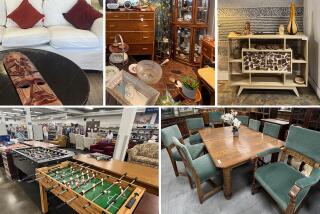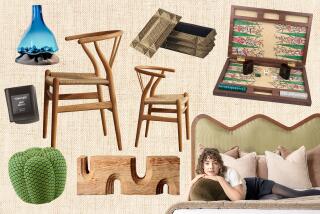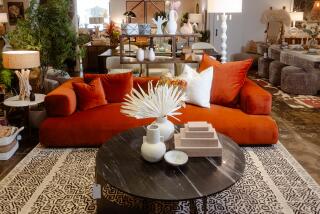Growing Spaces : Kids’ rooms: Designing environments for children that can accommodate them from the crib to college can test parents’ patience, imagination and pocketbooks.
Few things are as ephemeral as the motif of a growing child’s bedroom. Except perhaps a child’s shoe size.
It seems as soon as the crib is upgraded to that walnut-stained captain’s bunk, your toddler’s a teen-ager, swapping his Batman slipcovers for a jet-black duvet. And before you can sing “Happy Birthday,” he’s abandoning it for the college dormitory.
Brat.
In the space of about 18 years, parents find themselves in an endless quest to accommodate the fickle needs of a kid who one day wants a toy chest for his stuffed stegosaurus, the next is stuffing it with floppy disks and college catalogues. Too often, parents find these needs outgrow their pocketbooks.
Designing an environment for children that can take them from crayons to computers is the dilemma parents confront when looking at how to stretch their investment dollars, says Francine Pace, manager of Kids’ Quarters in Orange, which specializes in juvenile furniture. The issues, she says, are timelessness, versatility, and of course, where to put the goldfish.
Whether it’s pink or blue or has a bed shaped like a race car, a child’s bedroom is his or her first laboratory of self-expression.
Elaine Hankin of Elaine Hankin Interior Design in Huntington Beach says every child should have his or her own special place. For 6-month-old Christina Andrews’s room in Huntington Beach, Hankin commissioned a muralist to draw a fantasy-scape on one wall. Hankin says rooms should not be dated with trendy furnishings (“I never used avocado green or shag”) and that they should be comfortable enough for children to grow up in. For this reason, Christina’s mural doesn’t depict nursery characters but animals and fairies, and her crib will eventually convert into a bed.
“Buying children’s furniture is more interesting and exciting than buying other things for the home,” says Pace. “Parents feel obliged to learn at least six technical aspects of a product like a refrigerator. Buying things for a kid’s room is a lot more fun.”
That may be, but most parents would agree that there are still some technical aspects to choosing a design for their children’s room, based primarily on variables of style and function.
Pace says the most popular plan revolves around modular units--separate storage pieces that can be made to fit together in a variety of ways. “It’s affordable and adaptable,” Pace says. “And besides, there is always some piece that a grandparent can buy.”
Storage cabinets, drawers, desks and hutches, tables and even wardrobes can all be purchased according to the basic tenet of mix and match, Pace says. Within that framework, parents can custom design an environment that can be altered as quickly as their child changes grades.
Once the child has outgrown the crib, the logical place to start spending would be in the bed department.
The gamut at Kids’ Quarters runs from a twin bed of simple pine for around $120, to an oak bed “imported” from the East Coast for about $500. Similar prices can be found at Children’s World in Irvine, Kids’ Room in Tustin, Al’s Woodcraft in Tustin, Anaheim and Huntington Beach and STOR in Tustin.
Of course, beds can be as varied as the children who sleep in them. The captain’s bunk has always been popular because of its built-in storage space, and bunk beds are revered as an extension of the back yard Jungle Jim. Though Pace denies that bunk beds are necessarily juvenile, their design can present a problem to teen-agers who might one day decide that the bed they’ve slept in since kindergarten is now a total gross-out.
That’s when parents realize their initial mistake in planning their child’s room: They didn’t. Pace tries to stress versatility to young families--avoiding the cliches of childhood that spawn such trends as race car beds, in favor of more timeless designs. That way, the room can be given a fresh look simply by investing in a new bedspread and curtains--a much cheaper transition from toddler to teen.
The same basic rule applies when designing storage space for your child’s room. Pace says the most popular piece is the three-drawer chest, just short enough so that most kids can reach the top drawer. Their design can range from simple pine to sophisticated laminate--an attractive selling point for parents weary of fingerprints and scarring ballpoint pen marks.
As the need for space increases, more three-drawer chests can be added. STOR offers a four-drawer white-lacquered particleboard system for $99, with adaptable shelf and cabinet units. It also sells white-lacquered desktops that can be placed on top of two narrow drawer units that will suffice until your child goes to college.
Of course, parents can spend as much as they want on furniture for their children. Bellini, an upscale juvenile furniture store in Costa Mesa, specializes in Italian-made solid beechwood cribs, priced from $474 to $700. Manager Courtney Alford says that although Bellini is priced higher than most outlets, the long-term cost to parents is minimized because the cribs convert to youth beds that can be used by children until about age 4.
Bellini also sells changing tables, for around $580, that convert into full bookcases, and Canadian-made beechwood rockers that are pretty enough to complement any room from child to adult.
“It’s important to know how long the furniture (you’re buying) will last,” Alford says. “Is it durable enough to support older children? It’s hard for some people to look beyond the first couple of years,” she continues.
“Typically, after two years, they start to redo the nursery. That’s when they show up here.”
Part of children’s furniture buying savvy is knowing something about its manufacturers. The domestic furniture industry is fragmented, with more than 2,000 producers throughout the country, Pace says.
The East Coast, where the industry began, still specializes in hardwoods such as oak and maple. But because of the high cost of shipping, California has a plethora of local manufacturers offering furniture at competitive prices.
California entrepreneurs can offer pine, alder, and of course, redwood from the Northwest, and ship them locally, saving 18% off their retail price tag. A standard oak bunk bed set from the East Coast, says Pace, could cost as much at $800.
West Coast furniture outlets such as STOR keep freight costs even lower by shipping their wares unassembled, which makes for a more efficient package.
All of this means that parents on the West Coast can outfit their children’s rooms cheaper than parents in, say, Ohio.
So parents can afford to pay attention to style as well as function, says Jeff Lee, a STOR buyer. He says we are a generation of parents who definitely care about style.
“Juvenile furniture sales accelerated dramatically because of the baby boomers,” Lee says. “Women have more disposable income because they went out and built their careers and then had their families. They took time to think about their families, and they’re interested in providing as much quality for their children as possible.”
Mothers are also older today than they used to be, from 25 to 38, as opposed to “our mothers, who were 18,” according to Pace’s estimate. As a result, she says, “they have had time to research their choices. They’re generally more in tune with what’s available.” Which of course ultimately dictates what’s available.
The baby boomer generation has helped establish the American Furniture Manufacturer’s Assn., a voluntary organization with guidelines that set up safety precautions for furniture makers. The guidelines suggest such safety items as placing a sandpaper-like strip on the rungs of metal bunk bed ladders so that children do not fall through them.
Lee notes that it was this precautionary vision that prompted the redesign of the toy box, that age-old repository of childhood. The safer “storage bench” does not lock when it closes, avoiding the possibility of trapping a child inside. And though it may not accommodate all of the junk a child can possibly try to stuff into it, Kids’ Quarters still carries one, in solid maple, for $99.
And so does Bellini, in hand-painted solid beechwood, for $220.
Such well-bred quality seems to be making a comeback among homemakers who have, in the years since their liberation, relied on convenience and disposability for everything from diapers to dinner trays. Pointing again to the aspirations of the baby boom generation, Alford notes the phenomenal success of television’s “thirtysomething” in portraying the successful life as one lived among expensive and well-crafted possessions.
“There’s been a change in the market in just the last two years,” she notes. “Everyone’s more decorator-oriented. They want the look of quality.”
Indeed, Bellini furniture and accessories have appeared in many video images of the baby boom landscape--the Diane Keaton film “Baby Boom,” as well as “Miami Vice” and “All My Children,” to name a few.”
Such attention to quality and durability might help establish a new generation of family heirlooms, suggests Alford. “All of this stuff makes good hand-me-downs.”


